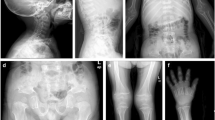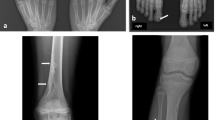Abstract
We present a child with irregular ossification of tubular bone epiphyses, short bones, and spine. The radiographic evolution of bones undergoing endochondral ossification was followed from the age of 1 year 9 months to 6 years. The unusual features demonstrated in this child made classification difficult: pseudoachondroplasia was excluded because no mutations of the COMP gene were found. Considering the evolution of the radiographic appearances, the most likely diagnosis would seem to be an unusual form of spondyloepiphyseal dysplasia, mimicking some aspects of multiple epiphyseal dysplasia. Endochondral ossification was diffusely altered with a mixture of epiphyseal ossification delay associated with acceleration and early fusion. This case was a unique presentation within the family, suggesting a mutation in the affected child.




Similar content being viewed by others
References
Superti-Furga A, Unger S (2007) Nosology and classification of genetic skeletal disorders; 2006 revision. Am J Med Genet A 143:1–18
Lachman RS, Krakow D, Cohn DH et al (2005) MED, COMP, multilayered and NEIN: an overview of multiple epiphyseal dysplasia. Pediatr Radiol 35:116–123
Briggs MD, Chapman KL (2002) Pseudoachondroplasia and multiple epiphyseal dysplasia: mutation review, molecular interactions, and genotype to phenotype correlations. Hum Mutat 19:465–478
Fairbank T (1947) Dysplasia epiphysealis multiplex. Br J Surg 34:225–232
Leeds NE (1960) Epiphysial dysplasia multiplex. Am J Roentgenol Radium Ther Nucl Med 84:506–510
Hulvey JT, Keats T (1969) Multiple epiphyseal dysplasia. A contribution to the problem of spinal involvement. Am J Roentgenol Radium Ther Nucl Med 106:170–177
Lachman RS (2007) Taybi and Lachman’s radiology of syndromes, metabolic disorders and skeletal dysplasias, 5th edn. Mosby Elsevier, Philadelphia
Castriota-Scanderberg A, Dalla Piccola B (2005) Abnormal skeletal phenotypes, from simple sign to complex diagnosis. Springer Verlag, Berlin
Author information
Authors and Affiliations
Corresponding author
Rights and permissions
About this article
Cite this article
Pazzaglia, U.E., Beluffi, G. & Zarattini, G. An unusual form of spondyloepiphyseal dysplasia, with advanced carpal and spinal end-plate ossification mimicking COMP-mutation-like multiple epiphyseal dysplasia. Pediatr Radiol 38, 783–787 (2008). https://doi.org/10.1007/s00247-008-0791-3
Received:
Revised:
Accepted:
Published:
Issue Date:
DOI: https://doi.org/10.1007/s00247-008-0791-3




